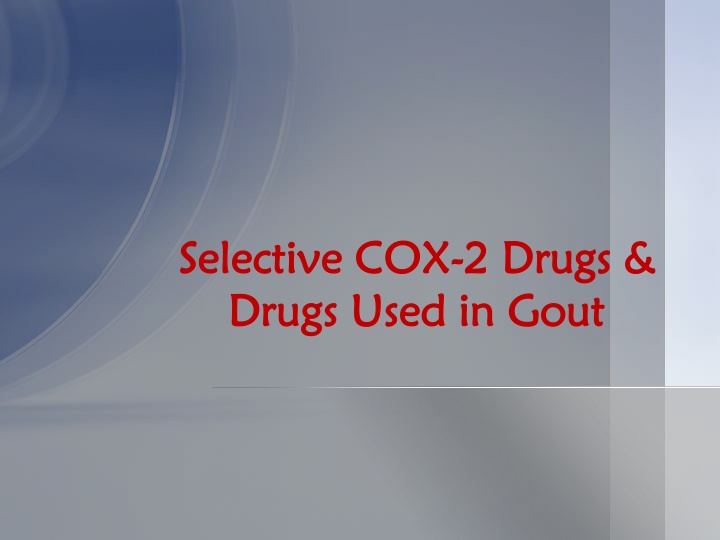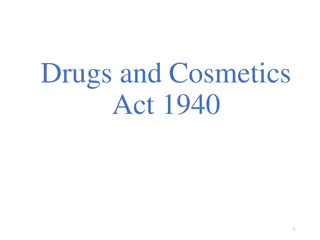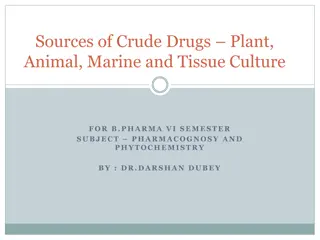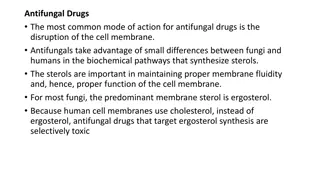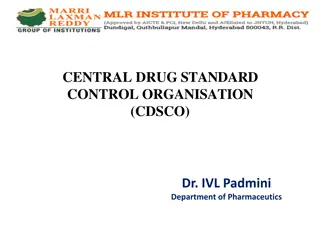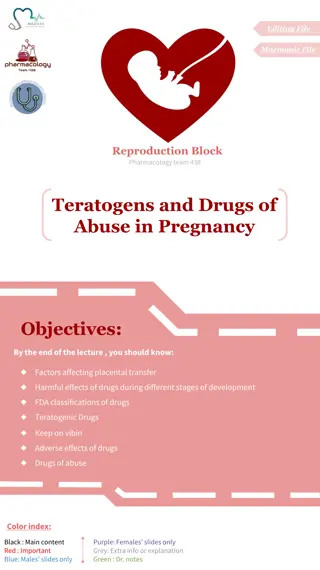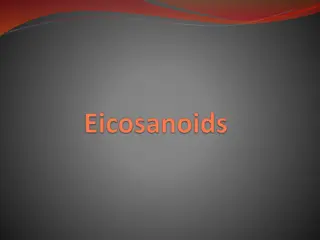Selective COX Selective COX- -2 Drugs &
Selective COX-2 inhibitors are a new group of drugs providing potent anti-inflammatory activity without significant GI toxicity. Celecoxib, the first marketed COX-2 inhibitor, is followed by rofecoxib and valdecoxib. Etoricoxib, approved worldwide except in the US, offers stronger analgesic efficacy. These drugs, known as coxibs, have varied pharmacokinetics and adverse effects, making them crucial choices in managing inflammatory conditions.
Download Presentation

Please find below an Image/Link to download the presentation.
The content on the website is provided AS IS for your information and personal use only. It may not be sold, licensed, or shared on other websites without obtaining consent from the author.If you encounter any issues during the download, it is possible that the publisher has removed the file from their server.
You are allowed to download the files provided on this website for personal or commercial use, subject to the condition that they are used lawfully. All files are the property of their respective owners.
The content on the website is provided AS IS for your information and personal use only. It may not be sold, licensed, or shared on other websites without obtaining consent from the author.
E N D
Presentation Transcript
Selective COX Selective COX- -2 Drugs & Drugs Used in Gout Drugs Used in Gout 2 Drugs &
The selective COX-2 inhibitors are a new group of drugs that provide potent antiinflammatory activity without causing significant GI toxicity. Celecoxib , Celecoxib , the first selective COX-2 inhibitor to be marketed, was soon followed by the release of rofecoxib and valdecoxib.The latter two drugs were withdrawn from the market because of the relative increase risk of confirmed cardiovascular events(e.g., heart attack and stroke). Etoricoxib Etoricoxib , another drug with claimed stronger analgesic efficacy than celecoxib, is currently approved in more than 80 countries worldwide but not in the US, where the Food and Drug Administration (FDA) has required additional safety and efficacy data for etoricoxib before approval. Together, these agents are known as coxibs.
Celecoxib Celecoxib Celecoxib is more selective for inhibition of COX-2 than of COX-1 (about 10 20 times ) It is approved for treatment of RA, osteoarthritis, and acute mild to moderate pain. Celecoxib has similar efficacy to NSAIDs in the treatment of pain Recent studies show that NSAIDs including celecoxib can delay or slow the progress of Alzheimer disease. In addition, celecoxib is found to be more effective than nonselective COX inhibitors in protecting against colon carcinogenesis. Pharmacokinetics Pharmacokinetics: : Celecoxib is readily absorbed, reaching a peak concentration in about 3 metabolized in the liver by cytochrome P450 (CYP2C9) and is excreted in the feces and urine. The half-life is about 11 hours, and the drug may be dosed once or twice daily. hours. It is extensively
Adverse effects: Adverse effects: Headache, dyspepsia, diarrhea, and abdominal pain are the most common adverse effects. Celecoxib is associated with less GI bleeding and dyspepsia than other NSAIDs. However, this benefit is lost when aspirin is added to celecoxib therapy. Patients who are at high risk of ulcers and require aspirin for cardiovascular prevention shouldavoid the use of celecoxib. It is contraindicated in patients who are allergic to sulfonamides ( because it is a sulfa-NSAID ). As with other NSAIDs, kidney toxicity and cardiovascular events. may occur Celecoxib should be avoided in patients with chronic renal insufficiency, severe heart disease, volume depletion, and/or hepatic failure Inhibitors of CYP2C9, such as fluconazole, fluvastatin, and zafirlukast, may increase serum levels of celecoxib.
CHOICE OF NSAID CHOICE OF NSAID All NSAIDs, including aspirin, are about equally efficacious with a few exceptions tolmetin seems not to be effective for gout, and aspirin is less effective than other NSAIDs (eg, indomethacin) for ankylosing spondylitis. For patients with renal insufficiency, nonacetylated (salicylate, sodium salicylate, and salicyl salicylate which are effective anti-inflammatory drugs, but they do not inhibit platelet aggregation.) may be best. nonacetylated salicylates salicylates Diclofenac and sulindac are associated with more liver function test abnormalities than other NSAIDs. The relatively expensive, selective COX-2 inhibitor celecoxib is probably safest for patients at high risk for GI bleeding but may have a higher risk of cardiovascular toxicity. The choice of an NSAID thus requires a balance of efficacy, cost- effectiveness, safety, and numerous personal factors (eg, other drugs also being used, concurrent illness, compliance), so that there is no best NSAID for all patients. There may, however, be one or two best NSAIDs for a specific person.
Drugs Used in Gout Drugs Used in Gout Gout is a metabolic disorder characterized by high levels of uric acid in the blood (hyperuricemia) causing recurrent episodes of acute arthritis due to deposition of monosodium urate in joints and cartilage (monosodium urate is the end product of purine metabolism in humans & it is poorly soluble substance). Uric acid renal calculi, tophi (uric acid masses in joints) and interstitial nephritis may also occur. Hyperuricemia does not always lead gout, but gout is always preceded by hyperuricemia. The prevalence of gout varies between populations but is approximately 1 2%, with a greater than 5 : 1 male predominance. It is the most common inflammatory arthritis in men and in older women. The risk of developing gout increases with age and with serum uric acid levels
Pathophysiology: Pathophysiology: About one-third of the body uric acid pool is derived from dietary sources and two-thirds from endogenous purine metabolism.The concentration of uric acid in body fluids depends on the balance between endogenous synthesis, and elimination by the kidneys (two-thirds) and gut (one-third). Purine nucleotide synthesis and degradation are regulated by a network of enzyme pathways. Xanthine oxidase Xanthine oxidase catalyses the end conversion of hypoxanthine to xanthine and then xanthine to uric acid. The causes of hyperuricemia are shown in the box. In over 90% of patients, the main abnormality is reduced uric acid excretion by the renal tubules, which impairs the body s ability to respond to a purine load. In many cases, it is genetically determined. The deposition of urate crystals initiates an inflammatory process, urate crystals are initially phagocytosed by synoviocytes which react by releasing eicosanoids, lysosomal enzymes, and IL-1. The above mediators attract leukocytes to the site that lead to augmentation of the inflammatory process in the joint. Later on, phagocytes appear which ingest the urate crystals and release more inflammatory mediators. This process generates oxygen metabolites, which damage tissues causing rupture of lysosome, followed by death of phagocyte and release of hydrolytic enzymes that evoke the inflammatory response.
Drugs used Drugs used Most therapeutic strategies for gout involve lowering the uric acid level below the saturation point (<6 mg/dL), thus preventing the deposition of urate crystals. This can be achieved by: 1) Interfering with uric acid synthesis with xanthine oxidase oxidase inhibitors ( inhibitors (allopurinol allopurinol, , febuxostat 2) Increasing uric acid excretion with uricosuric agents: probenecid probenecid or sulfinpyrazone sulfinpyrazone 3) Inhibiting leukocyte entry into the affected joint with colchicine colchicine 4) By general anti-inflammatory and analgesic effects (NSAIDs NSAIDs and occasionally glucocorticoids). xanthine febuxostat) )
Treatment of acute gout Treatment of acute gout Acute gouty attacks can result from a number of conditions, including excessive alcohol consumption, a diet rich in purines, or kidney disease. NSAIDs, corticosteroids, and colchicine are effective agents for the management of acute gouty arthritis. Indomethacin is considered the classic NSAID of choice, although all NSAIDs are likely to be effective in decreasing pain and inflammation.[Note: low dose of aspirin is contraindicated, because it competes with uric acid for the organic acid secretion mechanism in the proximal tubule of the kidney.] Intra-articular administration of glucocorticoids (when only one or two joints are affected) is also appropriate in the acute attack. Patients are candidates for prophylactic therapy (e.g with allopurinol) if they have had more than two attacks per year, the first attack is severe or complicated with kidney stones or tophi and serum urate is greater than 10 mg/dL or urinary urate excretion exceeds 800 mg per 24 hours.
Treatiment Treatiment of chronic gout of chronic gout Chronic gout can be caused by: 1) A genetic defect, such as one resulting in an increase in the rate of purine synthesis 2) Renal insufficiency 3) Excessive production of uric acid e.g. with cancer chemotherapy Urate-lowering therapy for chronic gout aims to reduce the frequency of attacks and complications of gout. Treatment strategies for chronic gout include the use of xanthine oxidase inhibitors to reduce the synthesis of uric acid or use of uricosuric drugs to increase its excretion. Xanthine oxidase inhibitors are first-line urate-lowering agents especially in patients with excessive uric acid synthesis, with previous histories of uric acid stones, or with renal insufficiency while uricosuric agents can be used for patients with gout associated with reduced urinary excretion of uric acid. [Note: [Note: Initiation of urate-lowering therapy can precipitate an acute gout attack due to rapid changes in serum urate concentrations. Medications for the prevention of an acute gout attack (low-dose colchicine or NSAIDs) should be initiated with urate-lowering therapy and continued for at least 6 months until steady-state serum uric acid is normalized or decreased to less than 6 mg/dL.
Colchicine Colchicine Colchicine, a plant alkaloid, has been used for the treatment of acute gouty attacks as well as chronic gout. Colchicine has a suppressive and prophylactic effect that reduces the frequency of acute attacks and relieves pain. Mechanism of action: Mechanism of action: Colchicine binds to tubulin and prevents tubulin polymerization and microtubule formation. This disrupts cellular functions, such as the mobility of neutrophils, thus decreasing their migration into the inflamed joint Furthermore, colchicine blocks cell division by binding to mitotic spindles. It also inhibits the synthesis and release of the leukotriene B4 and IL-1 .
Therapeutic uses: Therapeutic uses: The anti-inflammatory activity of colchicine is specific for gout, usually alleviating the pain of acute gout within 12 hours. [Note: Colchicine must be administered within 36 hours of onset of attack to be effective.] NSAIDs have largely replaced colchicine in the treatment of acute gouty attacks for safety reasons. Colchicine is also used as a prophylactic agent to prevent acute attacks of gout in patients initiating urate-lowering therapy. Pharmacokinetics: Pharmacokinetics: Colchicine is administered orally, followed by rapid absorption from the GI tract. It is recycled in the bile and is excreted unchanged in the feces or urine. Adverse effects: Adverse effects: It may cause nausea, vomiting, abdominal pain, and severe diarrhea. Hepatic necrosis, acute renal failure, disseminated intravascular coagulation, and seizures have also been observed. Chronic administration may lead to myopathy, neutropenia, aplastic anemia, and alopecia. The drug should not be used in pregnancy, and it should be used with caution in patients with hepatic, renal, or cardiovascular disease.
Allopurinol Allopurinol Allopurinol is a purine analog. It is the preferred and standard-of- care therapy for gout during the period between acute episodes. It reduces the production of uric acid by competitively inhibiting the last two steps in uric acid biosynthesis that are catalyzed by xanthine oxidase. [Note: Uric acid is less water soluble than its precursors. When xanthine oxidase is inhibited, the circulating purine derivatives are xanthine and hypoxanthine which are more soluble and, therefore, are less likely to precipitate.] In contrast to uricosuric drugs, allopurinol causes a decrease in uric acid excretion and a corresponding increase in the excretion of hypoxanthine. Allopurinol also increases reutilization of hypoxanthine and xanthine for nucleotide and nucleic acid synthesis. The resultant increase in nucleotide concentration leads to increased feedback inhibition of de novo purine synthesis.
Therapeutic uses: Therapeutic uses: Allopurinol is effective in the treatment of primary hyperuricemia of gout and hyperuricemia secondary to other conditions, such as that associated with certain malignancies (those in which large amounts of purines are produced, particularly after treatment with chemotherapeutic agents). Note: Allopurinol is ineffective in the treatment of an acute attack (because it may exacerbate the inflammation). Pharmacokinetics: Pharmacokinetics: Allopurinol is completely absorbed after oral administration. The primary metabolite is the active alloxanthine (oxypurinol), which is also a xanthine oxidase inhibitor with a half-life of 15 to 18 hours; the half-life of allopurinol is 2 hours. Thus, effective inhibition of xanthine oxidase can be maintained with once-daily dosage. The drug and its active metabolite are excreted in the feces and urine.
Adverse effects: Adverse effects: Allopurinol is well tolerated by most patients. Hypersensitivity reactions, especially skin rashes are the most common adverse reactions. Acute attacks of gout may occur more frequently during the first several months of therapy; therefore, colchicine or NSAIDs should be administered concurrently. GI side effects, such as nausea and diarrhea, are common. Allopurinol interferes with the metabolism of the anticancer agent 6-mercaptopurine and the immunosuppressant azathioprine (which are metabolized by xanthine oxidase) requiring a reduction in dosage of these drugs by about 75%. It is contraindicated in pregnancy because of suspected congenital malformations.
Febuxostat Febuxostat Febuxostat is the first nonpurine inhibitor of xanthine oxidase. Pharmacokinetics: Pharmacokinetics: 80% absorbed following oral administration, maximum concentration is reached in 1 hour. Febuxostat is extensively metabolized in the liver, the drug and its metabolite eliminated in urine. It is more potent than allopurinol and more selectively inhibit xanthine oxidase. Adverse Effects: Adverse Effects: Its adverse effect profile is similar to that of allopurinol, although the risk for rash and hypersensitivity reactions may be reduced. Febuxostat does not have the same degree of renal elimination as allopurinol and thus requires less adjustment in those with reduced renal function. Febuxostat should be used with caution in patients with a history of heart disease or stroke, as this agent may be associated with a greater risk of these events as compared to allopurinol. It has the same drug interactions of allopurinol with 6-mercaptopurine & azathioprine. As with allopurinol, prophylactic treatment with colchicine or NSAIDs should be started at the beginning of therapy to avoid gout flares.
Uricosuric Uricosuric agents: The uricosuric drugs are weak organic acids that promote renal clearance of uric acid by inhibiting the urate-anion exchanger in the proximal tubule that mediates urate reabsorption. Probenecid Probenecid and sulfinpyrazone sulfinpyrazone , a derivative of phenylbutazone, are the two most commonly used uricosuric agents. Lesinurad Lesinurad is a promising new uricosuric agent which inhibits the function of transporter proteins involved in uric acid reabsorption in the kidney. Pharmacodynamics: Pharmacodynamics: Uricosuric drugs (probenecid, sulfinpyrazone, and large doses of aspirin) prevent the reabsoption of uric acid from proximal tubules leading to reduction in the total urate pool. Reduction in the total pool of urate associated with decreased tophaceous deposits of urate and relief of arthritis. Uricosuric therapy should be initiated in gouty underexcretion of uric acid when allopurinol is contraindicated or when tophi are present. agents: Probenecid Probenecid and and sulfinpyrazone sulfinpyrazone
Pharmacokinetics: Pharmacokinetics: Probenecid is completely reabsorbed by the renal tubules and metabolized by the liver (half-life 5-8 hours). Sulfinpyrazone or its hydroxylated derivative is rapidly excreted by the kidney. Adverse effects: Adverse effects: These drugs have few adverse effects; however; sulfinpyrazone inhibits prostaglandin synthesis and shares some of the risks associated with NSAIDs, including the potential for causing GI, renal, or hematologic adverse effects. Probenecid may cause nephrotic syndrome. Probenecid blocks the tubular secretion of penicillin and is sometimes used to increase levels of the antibiotic in severe infections. It also inhibits excretion of naproxen, ketoprofen, and indomethacin. Both drugs increase the formation of renal stones, therefore a large volume of fluid should be taken and at least early in treatment, the urine pH should be kept above 6.0 by the administration of alkali.
Catabolic Enzyme Preparations Catabolic Enzyme Preparations In animals uric acid is converted by the enzyme uricase very soluble excretion product, which is freely eliminated by the urine so animals have very low serum urate levels. Pegloticase recombinant recombinant uricase uricase recently approved for the patients with refractory chronic gout as an intravenous infusion formulation. Pegloticase has been shown to maintain low urate levels for up to 21 days after a single dose at doses of 4 12 mg, allowing for IV dosing every 2 weeks. uricase to allantoin, a Pegloticase is a Pegloticase must be administered in the clinic with supportive measures available nearby, as there is the risk of life-threatening allergic reactions. Nephrolithiasis, arthralgia, muscle spasm, headache, anemia, and nausea may occur. A similar recombinant uricase enzyme, rasburicase the initial management of plasma uric acid levels in pediatric and adult patients with leukemia, lymphoma, and solid tumor malignancies who are receiving anticancer therapy. Its administration by the intravenous route carries the same risks of allergic reactions as pegloticase. rasburicase, , is indicated only for
